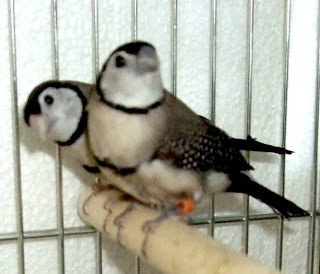We acquired these three little cuties last week. Brother Bo and Big Daddy have been raising them since they lost little Tasha and they have been rapidly multiplying. These are the first hatchlings from their finch family and when Steve and I visited he fell in love with them. Since there are more eggs in the original nest, there are more to come - it started out with four and now there are nine plus. My Dad's father raised canaries and had an aviary in the basement so I am sure this brings fond memories for him.
They wake up a little after 7 in the morning. I bring them in the dining room where they can be around the action and have the sun shine on them. Since we are remodeling, the room is quite empty and their sound is magnified. The cutest thing was when the sparrows, finches and cardinals from outside started peeking in our window to see the little guys. Nature is so entertaining. I placed the swing in the center of their cage and they take turns performing for us.
golden finches
Finches are one of the most common birds and have a long history of being kept for their beauty and lovely vocalizations. The society finch was being bred in China at least 500 years ago. Wealthy members of Victorian Britain once kept finches as status symbols in their homes to liven the decor. Although they do not bond to humans like parakeets and parrots do, finches are considered excellent pets. They learn to tolerate the presence of people but tend not to like being touched or handled. In fact, finches prefer the company of other finches rather than that of humans. Although finches require daily care and observation, they don't mind if you go to work and leave them with their pals all day.
wild zebra finches
The word finch has come to mean 'any variety of small seed-eating birds with a stout bill.' The name finch has been applied to at least 11 different families of birds around the world, although there is really only one group of 'true finches', the taxonomic family Fringillidate. Surprisingly, this family includes the popular canary, which few people would think of as a finch. My Dad often refers to them as canaries and we buy birdfood that is labeled for finches and canaries. Canaries are actually 'true finches'. Finches weigh from 7 to 30 grams and their length is between 3 and 8 inches. They have beaks that are designed for seed husking, although most of them eat insects as well.
owl finches
Finches have relatively short lives and tend to live from 4 to 9 years. Finches are sensitive birds and although they can come to feel comfortable around humans, they do not enjoy being scratched or held. A healthy finch will be alert and active. They are busy birds, moving about their enclosure constantly. Most finches make peeps and beeps throughout the day and some may sing in the mornings and evenings. Males are more brightly colored than females. They are more aggressive and sing in courtship. Females don't sing and they do lay eggs. Finches will learn to recognize you and perhaps even interact with you, but they will always prefer other finches for company. You should always have at least two finches. You can teach your finch to trust you and maybe even fly to your fingers. You will have to spend a lot of time near the cage, sitting quietly to start with so that the finch learns not to worry about your presence. Then begin offering them treats. I have been reading my books right near them and they are already comfortable with me. They quiet down when Thumper comes by for they are still not sure of her, but it doesn't take long and they resume their activity, for she sits nearby as if protecting them.

strawberry finches
In caring for finches, their cage should be longer than it is high, leaving open space for zipping back and forth. Finches need sunlight so keeping a cage near a sunny window that isn't drafty is excellent. In the warmer months, moving the cage onto a patio or other safe and sunny place is wonderful for finches. Sunlight is an important factor in the health and well-being of the little birds. Just make sure the cage is protected from direct sunlight and that some part of the cage remains in the shade. Perches should be no more than 3/8 to 1/2 inches wide. Plastic perches should be avoided for it will make them difficult for the birds to grasp. Take care not to place them over food and water bowls so that the birds do not defecate in them. Four or five perches in a cage are sufficient. Newspaper is best for the bottom of cages. Plastic is the least desirable choice for bowls; stainless steel is better. A ceramic or stainless steel bowl should also be left out for bathing. Cage covers should not have frayed edges or loose strings as finches searching for nesting material can get tangled in the thread and injure themselves. Lighting is important, especially if you are breeding finches. Length of day is a critical factor in giving finches time to eat enough to maintain energy required to raise a brood of chicks. Natural light is a means of generating esential vitamins and overall well-being. Some finches will not come into their full colors unless they have enough natural light. For nesting, many finches prefer a wicker-type nest. Unlike parrots, parakeets and cockatiels, finches don't really play with toys, but ours love the swing.
firetail finch
Keeping too many birds in your cage is an easy way to instantly have cleaning issues. Overcrowded cages are not only dirty but dangerous. Birds can easily get ill and may even get aggressive with one another. Grape seed extract makes a wonderful safe disinfectant. If you lose a finch outside, chances are you won't get it back. Getting lost outside is pretty much a death sentence for these little birds. If your lost finch is still around and has a mate, you can put the cage outside and see if the finch will come back to land on top of it.
purple finch
Every day you should supply your finches with a variety of fresh seeds, dark green, leafy vegetables (we use spring greens) chopped orange vegetables, a variety of fresh fruit, fresh water, calcium and gritt. Finches love millet spray. Spinach greens may provide a bath in wet leaves. Carrots, yams, peas, pumpkin and cucumbers can be diced into small pieces as well as apples, melon and grapes. You can add almost any fruit or vegetable except avocados, which are toxic to birds. Stay away from sugar, salt, fatty human foods, chocolate, avocado and alcohol and caffeinated beverages. Eggs are another great supplement for finches. Not only are they high in protein, but if you leave the shell as part of the package, they also have the added benefit of calcium. Boil eggs for at least half an hour before serving in order to kill any bacteria that might be in the egg. The boiled egg can be crushed, shell and all, and served. Eggs should be only an occasional treat. Some 'people food' that can be beneficial can be found in bread soaked in milk, cheese, and whole wheat bread. As for live food, mealworms and fruit flies are one of the most common addition to finch diets, as are wax worms and crickets.

Don't clip your finch's wings. You may think they would be easier to catch and tame, however, finches cannot climb on the bars of their cages like a parrot. They have no way to get around without their wings. They need them to hop around from perch to perch and to feel secure. Finches that are clipped will be clumsy and stressed. If you have a pair of finches, chances are the hen will lay eggs. Even if you have a hen without a mate, she may lay eggs (although these eggs will not hatch.) Finches don't have to breed, however, just avoid giving them nests and nesting material. Remove eggs as they are laid. The birds won't mind. If you want to breed, the eggs should hatch 12 to 15 days after the pair has started to incubate them. The chicks will break their way out into the world on their own slowly and ease themselves out of their egg shells. All chicks are completely dependent on their parents. Do not disturb the nest for at least three or four days after the birds hatch. Finches, especially new parents, may abandon their babies if disturbed. Abandoned babies will die. Most finches will open their eyes when they are between 5 and 8 days old. After this, their feathers will start to come in. The chicks will then begin to pop their heads out of the nest and check out the world. When they have all their feathers, they will begin to explore.
It's important to keep a reference book handy to research any concerns. The joy these little guys bring is precious. The other day one of them was dancing ~ bopping around to the music from an Xfinity commerical. Simple pleasures. xo
Finches are one of the most common birds and have a long history of being kept for their beauty and lovely vocalizations. The society finch was being bred in China at least 500 years ago. Wealthy members of Victorian Britain once kept finches as status symbols in their homes to liven the decor. Although they do not bond to humans like parakeets and parrots do, finches are considered excellent pets. They learn to tolerate the presence of people but tend not to like being touched or handled. In fact, finches prefer the company of other finches rather than that of humans. Although finches require daily care and observation, they don't mind if you go to work and leave them with their pals all day.
wild zebra finches
The word finch has come to mean 'any variety of small seed-eating birds with a stout bill.' The name finch has been applied to at least 11 different families of birds around the world, although there is really only one group of 'true finches', the taxonomic family Fringillidate. Surprisingly, this family includes the popular canary, which few people would think of as a finch. My Dad often refers to them as canaries and we buy birdfood that is labeled for finches and canaries. Canaries are actually 'true finches'. Finches weigh from 7 to 30 grams and their length is between 3 and 8 inches. They have beaks that are designed for seed husking, although most of them eat insects as well.
owl finches
Finches have relatively short lives and tend to live from 4 to 9 years. Finches are sensitive birds and although they can come to feel comfortable around humans, they do not enjoy being scratched or held. A healthy finch will be alert and active. They are busy birds, moving about their enclosure constantly. Most finches make peeps and beeps throughout the day and some may sing in the mornings and evenings. Males are more brightly colored than females. They are more aggressive and sing in courtship. Females don't sing and they do lay eggs. Finches will learn to recognize you and perhaps even interact with you, but they will always prefer other finches for company. You should always have at least two finches. You can teach your finch to trust you and maybe even fly to your fingers. You will have to spend a lot of time near the cage, sitting quietly to start with so that the finch learns not to worry about your presence. Then begin offering them treats. I have been reading my books right near them and they are already comfortable with me. They quiet down when Thumper comes by for they are still not sure of her, but it doesn't take long and they resume their activity, for she sits nearby as if protecting them.

strawberry finches
In caring for finches, their cage should be longer than it is high, leaving open space for zipping back and forth. Finches need sunlight so keeping a cage near a sunny window that isn't drafty is excellent. In the warmer months, moving the cage onto a patio or other safe and sunny place is wonderful for finches. Sunlight is an important factor in the health and well-being of the little birds. Just make sure the cage is protected from direct sunlight and that some part of the cage remains in the shade. Perches should be no more than 3/8 to 1/2 inches wide. Plastic perches should be avoided for it will make them difficult for the birds to grasp. Take care not to place them over food and water bowls so that the birds do not defecate in them. Four or five perches in a cage are sufficient. Newspaper is best for the bottom of cages. Plastic is the least desirable choice for bowls; stainless steel is better. A ceramic or stainless steel bowl should also be left out for bathing. Cage covers should not have frayed edges or loose strings as finches searching for nesting material can get tangled in the thread and injure themselves. Lighting is important, especially if you are breeding finches. Length of day is a critical factor in giving finches time to eat enough to maintain energy required to raise a brood of chicks. Natural light is a means of generating esential vitamins and overall well-being. Some finches will not come into their full colors unless they have enough natural light. For nesting, many finches prefer a wicker-type nest. Unlike parrots, parakeets and cockatiels, finches don't really play with toys, but ours love the swing.
firetail finch
Keeping too many birds in your cage is an easy way to instantly have cleaning issues. Overcrowded cages are not only dirty but dangerous. Birds can easily get ill and may even get aggressive with one another. Grape seed extract makes a wonderful safe disinfectant. If you lose a finch outside, chances are you won't get it back. Getting lost outside is pretty much a death sentence for these little birds. If your lost finch is still around and has a mate, you can put the cage outside and see if the finch will come back to land on top of it.
purple finch
Every day you should supply your finches with a variety of fresh seeds, dark green, leafy vegetables (we use spring greens) chopped orange vegetables, a variety of fresh fruit, fresh water, calcium and gritt. Finches love millet spray. Spinach greens may provide a bath in wet leaves. Carrots, yams, peas, pumpkin and cucumbers can be diced into small pieces as well as apples, melon and grapes. You can add almost any fruit or vegetable except avocados, which are toxic to birds. Stay away from sugar, salt, fatty human foods, chocolate, avocado and alcohol and caffeinated beverages. Eggs are another great supplement for finches. Not only are they high in protein, but if you leave the shell as part of the package, they also have the added benefit of calcium. Boil eggs for at least half an hour before serving in order to kill any bacteria that might be in the egg. The boiled egg can be crushed, shell and all, and served. Eggs should be only an occasional treat. Some 'people food' that can be beneficial can be found in bread soaked in milk, cheese, and whole wheat bread. As for live food, mealworms and fruit flies are one of the most common addition to finch diets, as are wax worms and crickets.

gouldian finches
It's important to keep a reference book handy to research any concerns. The joy these little guys bring is precious. The other day one of them was dancing ~ bopping around to the music from an Xfinity commerical. Simple pleasures. xo














































